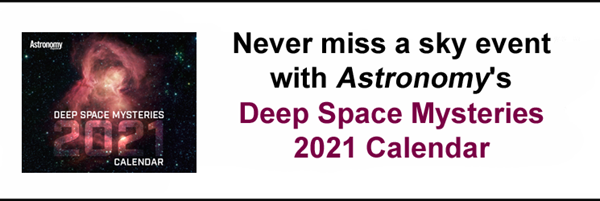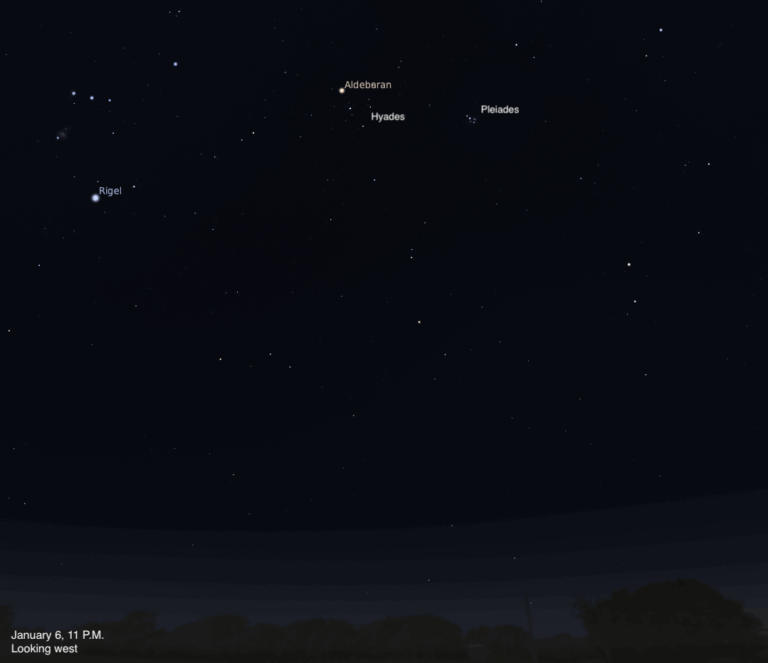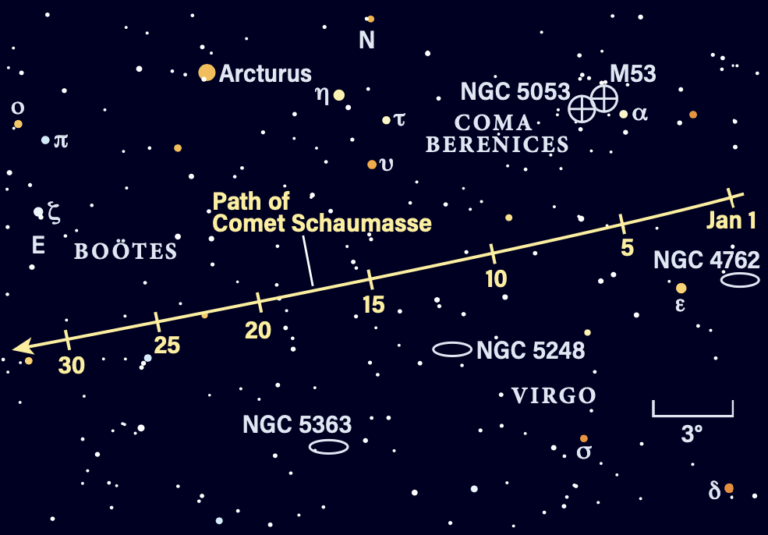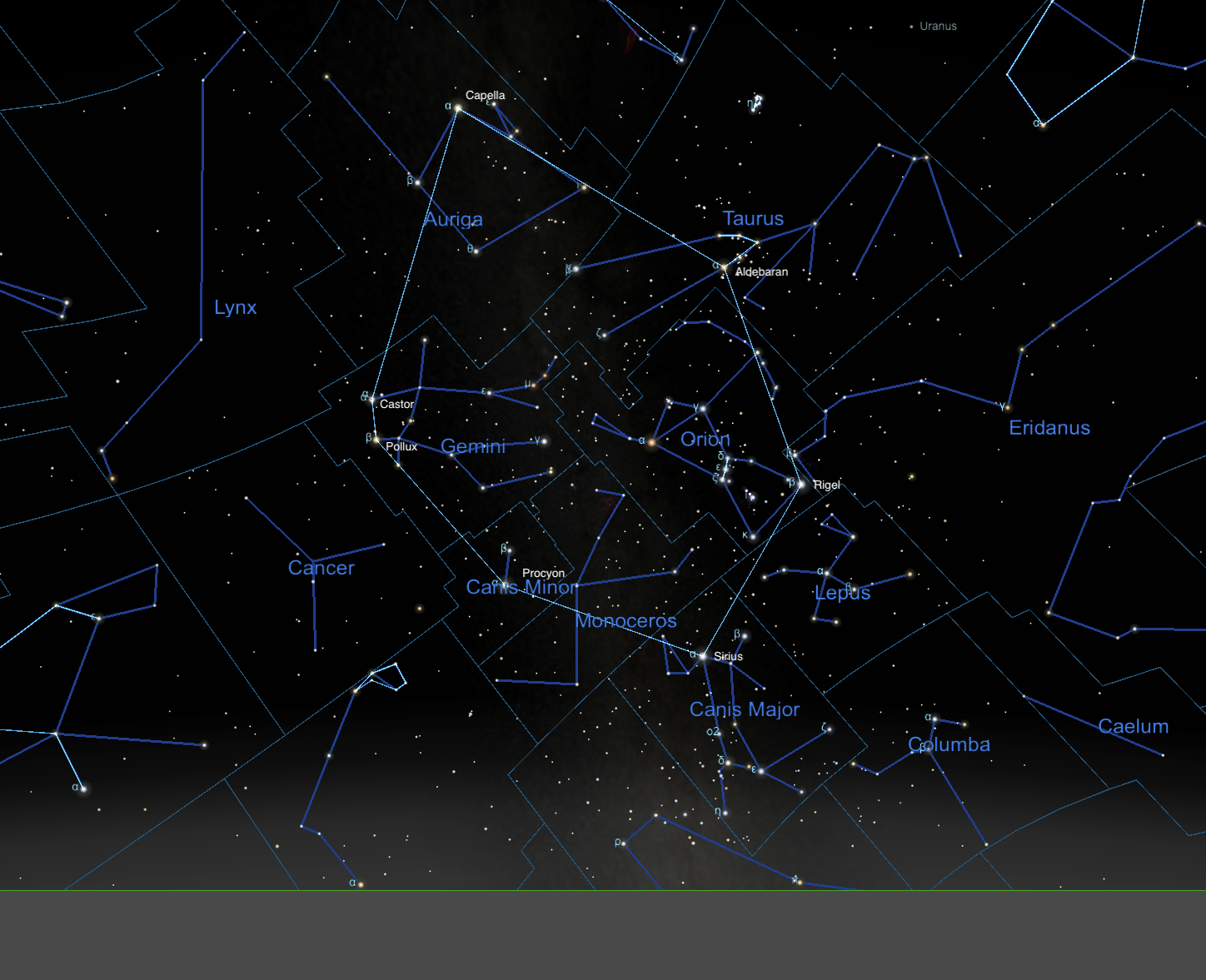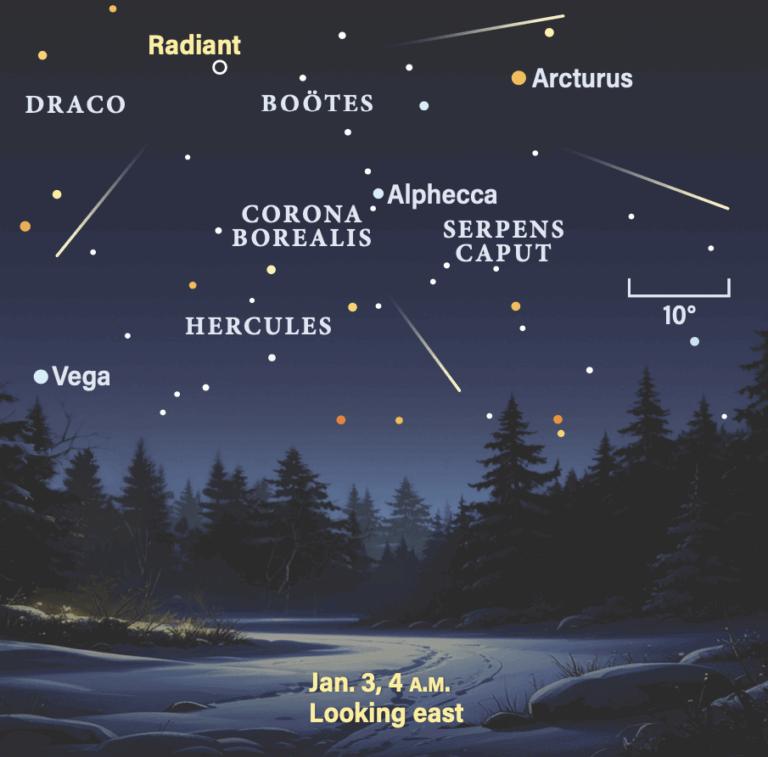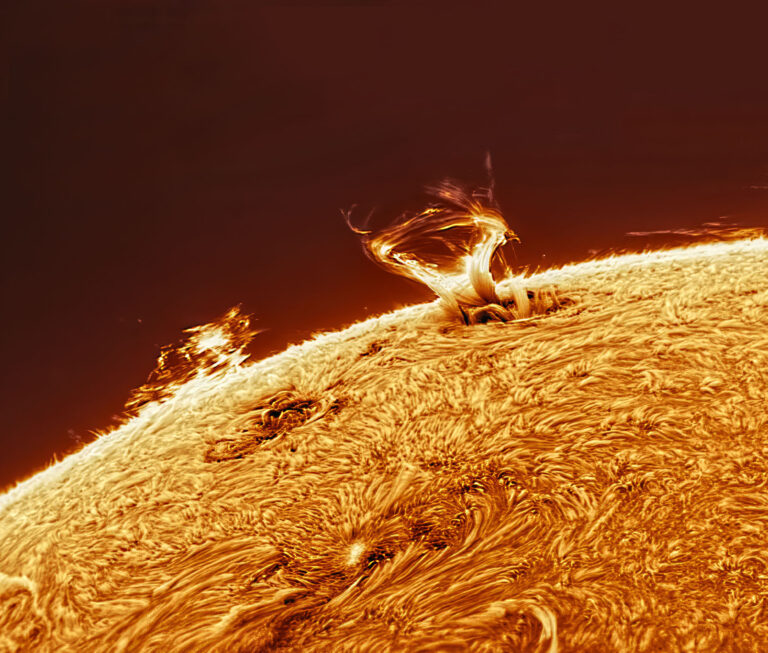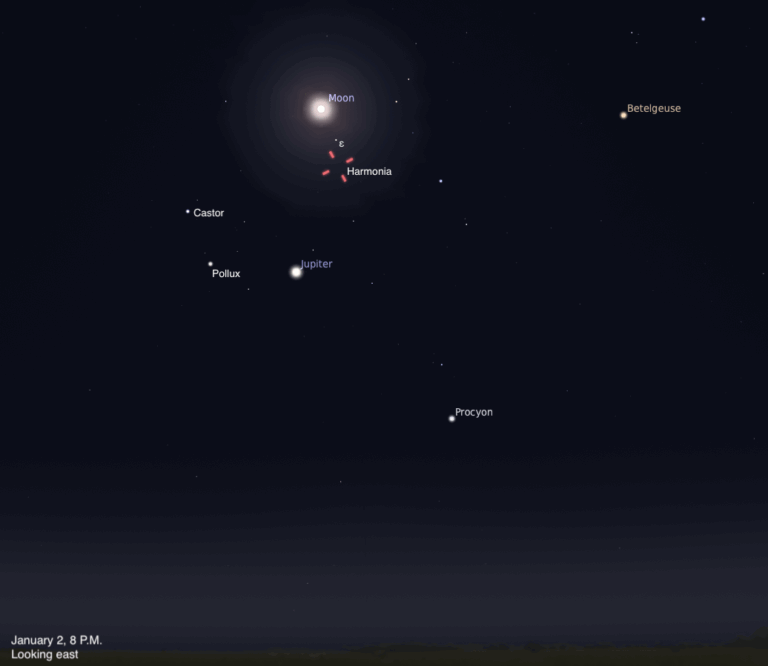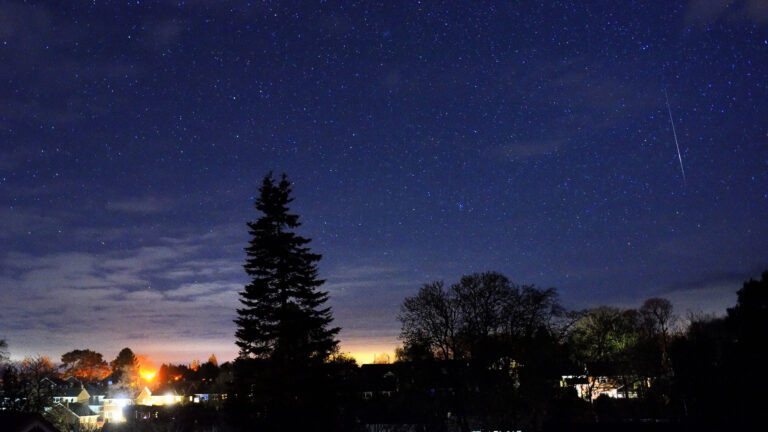Key Takeaways:
Comet 88P/Howell is slowly fading, but its 11th- to 12th-magnitude glow is within reach of a 6-inch scope under dark skies. Early this evening, you’ll find it among the stars of Aquarius, less than 7° northwest of globular cluster NGC 7492. The two should be similar in brightness and likely even appearance, although long-exposure images of Howell might still reveal a hint of its green-hued glow.
Once you’ve found the comet, look also 8.5° to its east-northeast, where you’ll see the slightly brighter magnitude 10.6 spiral galaxy NGC 7727. Nearby is also planet Neptune, just 1.5° northeast of 4th-magnitude Phi (φ) Aquarii. We’ll come back to study the ice giant in more detail later this week. In the meantime, Howell will continue approaching Neptune’s position, although its closest approach will be washed out by moonlight.
Sunrise*: 7:20 A.M.
Sunset: 5:00 P.M.
Moonrise: 9:21 A.M.
Moonset: 7:46 P.M.
Moon Phase: Waxing crescent (8%)
*Times for sunrise, sunset, moonrise, and moonset are given in local time from 40° N 90° W. The Moon’s illumination is given at 12 P.M. local time from the same location.
A brilliantly shining planet Venus (magnitude –3.9) rises about an hour before the Sun. Thirty to 40 minutes before sunrise, look southeast with binoculars or a small scope to locate the planet, then scan 1.5° south-southwest to see if you can spot the globular cluster M22 nearby. The pair is rising quickly, but so is the Sun, brightening the background sky.
However, a few bright stars may also remain as the sky grows lighter. Glance east to see if you can still spot Altair, the brightest star in Aquila the Eagle, famous as one of the points in the Summer Triangle. In the south is bright orange Antares, the heart of Scorpio the Scorpion. Farther south is Menket, part of Centaurus the Centaur. And higher in the sky is Spica, the brightest star in Virgo the Maiden.
Sunrise: 7:20 A.M.
Sunset: 5:01 P.M.
Moonrise: 9:51 A.M.
Moonset: 8:50 P.M.
Moon Phase: Waxing crescent (14%)
Sunday, January 17
Return to Aquarius shortly after sunset to find Neptune again. It’s an easy magnitude 7.8, making it a great binocular target, although its tiny 2″-wide disk will show no detail. Instead, it will look like a “flat” blue-gray star when compared with the surrounding luminaries.
Tonight, Neptune begins passing between two 6th-magnitude field stars, which sit roughly 1° apart. The planet will take several nights to inch through this gap, completing its journey by the 23rd. Come back night after night to watch its progress.
Glance east of Neptune and you’ll find the waxing crescent Moon, roughly 8.5° from the planet two hours after sunset. The Moon will pass 4° south of Neptune at 1 A.M. EST, after the pair has set below the horizon.
Sunrise: 7:19 A.M.
Sunset: 5:02 P.M.
Moonrise: 10:18 A.M.
Moonset: 9:52 P.M.
Moon Phase: Waxing crescent (22%)
Monday, January 18
By this evening, the Moon has passed into Cetus the Whale and its growing light rules the south. Instead, turn north after dark, where the cup of the Little Dipper is swinging low, coming closest to the horizon roughly two hours after sunset. The lowest star, which represents the lower right-hand corner of the cup, is magnitude 3 Pherkad. To its upper right is brighter magnitude 2 Kochab.
Pinned in the sky 16.5° due north of Kochab is Polaris, Ursa Minor’s alpha star and Earth’s famous North Star. However, it’s only a touch brighter than Kochab — at magnitude 1.97, Polaris is nowhere near the brightest star in the sky. It gains its fame from the fact that it’s the only star in the Northern Hemisphere sky that remains fixed in place as Earth turns on its axis. The stars nearby appear to circle around it, earning them the classification of “circumpolar stars.”
The Little Dipper itself is an asterism, or unofficial grouping of stars, within the official constellation Ursa Minor the Little Bear. The Dipper’s long handle is actually the Bear’s elongated tail, stretched out when the Greek god Zeus flung him — and his mother, nearby Ursa Major — into the sky by their tails.
Sunrise: 7:19 A.M.
Sunset: 5:03 P.M.
Moonrise: 10:42 A.M.
Moonset: 10:52 P.M.
Moon Phase: Waxing crescent (30%)
Tuesday, January 19
The constellation Andromeda holds many favorite observing targets, perhaps the greatest of which is the Andromeda Galaxy (M31). Visible to the naked eye on a dark night, this nearby (2.5 million light-years) galaxy is easy to find with binoculars or a telescope. If you’re star hopping to your destination, you’ll find it about 7.8° northwest of magnitude 2 Mirach and 1.5° west of magnitude 4.5 Nu (ν) Andromedae.
M31 is a gorgeous galaxy worth drinking in. After you’ve enjoyed the view, scan back to Mirach and then look 12.5° northeast to reach magnitude 2 Almach. You’ll likely notice (with optical aid) that this is not one, but two stars: one brighter and yellow-gold, one fainter and blue-green. Considered one of the night sky’s best colored double stars, this pair actually hides two more stars — both visible stars are themselves binaries, making Almach a quadruple-star system.
Sunrise: 7:18 A.M.
Sunset: 5:04 P.M.
Moonrise: 11:05 A.M.
Moonset: 11:51 P.M.
Moon Phase: Waxing crescent (40%)
Wednesday, January 20
First Quarter Moon occurs at 4:02 P.M. EST. Already well above the horizon at sunset, our satellite is primed for a great night of lunar observing. You’ll find it in Pisces, near the border the Fish share with Cetus and Aries. Nearby are Mars and Uranus; the Moon will pass close to this pair of planets early tomorrow morning, and we’ll return to take a look tomorrow evening.
Easily visible on the First Quarter Moon are the Seas of Serenity, Tranquillity, and Fertility. Smaller seas include Cold, Nectar, and Crises. On the Moon’s northern hemisphere, craters such as Aristoteles, Atlas, and Hercules should be easy to pick out. Farther south, Hipparchus and Albategnius lie close to the terminator that separates lunar day from night. Be aware that your telescope might flip the image, making north appear south and vice versa.
Sunrise: 7:18 A.M.
Sunset: 5:05 P.M.
Moonrise: 11:29 A.M.
Moonset: —
Moon Phase: Waxing crescent (49%)
The Moon passes 5° south of Mars and 3° south of Uranus at 1 A.M. EST. Out satellite later reaches apogee, the farthest point from our planet in its orbit, at 8:11 A.M. EST. At that time, it will sit 251,258 miles (404,360 kilometers) away.
Asteroid 15 Eunomia reaches opposition at 2 P.M. EST.
Finally, under cover of darkness, Mars passes 1.7° north of Uranus at 7 P.M. EST. At magnitude 0.3, Mars is easily visible to the naked eye, while magnitude 5.8 Uranus will require binoculars or a telescope, particularly with the Moon nearby. The (apparently) faster-moving Red Planet has been trekking northeast all month, creeping closer to the more distant ice giant and finally, tonight, passing it. Mars will continue to pull away from Uranus in the coming weeks, while the latter appears to move significantly less due to its distance. However, Mars will remain a great visual signpost for finding Uranus for a while to come.
Sunrise: 7:17 A.M.
Sunset: 5:07 P.M.
Moonrise: 11:53 A.M.
Moonset: 12:49 A.M.
Moon Phase: Waxing gibbous (58%)
With the Moon setting shortly before 2 A.M., the best time for deep-sky viewing is early morning. At that time, Virgo is high in the sky, providing the perfect opportunity to search out the famous galaxy M87, one of our local universe’s most massive residents.
Occupying the heart of the Virgo Cluster, M87 is an ancient elliptical galaxy containing more than 2,000 Suns’ worth of mass. Through a telescope, it appears as a fuzzy sphere whose stars cannot be resolved. Astrophotographers may want to try to catch the massive, 18,000-light-year-long jet issuing from the galaxy’s center, an outflow powered by the galaxy’s central supermassive black hole. This is the same black hole, by the way, imaged by the Event Horizon Telescope when it released the first-ever photo of a black hole in 2019.
Sunrise: 7:16 A.M.
Sunset: 5:08 P.M.
Moonrise: 12:20 P.M.
Moonset: 1:49 A.M.
Moon Phase: Waxing gibbous (67%)





